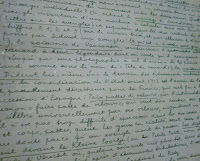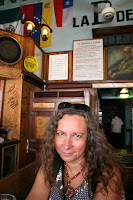It varies a well known bible verse from (St. Paul's Epistle to the) Romans 6:9 as the repeating phrase at the opening and closing of each of the three stanzas. This repetition and the insistent rhythm gives the poem its power as a meditation on immortality. If you're going to say something more than once, make it something worth hearing.
 |
| Boats at Laugharne |
'Dead men naked they shall be one
With the man in the wind and the west moon.'
'Under the windings of the sea
They lying long shall not die windily.'
'Where blew a flower may a flower no more
lift its head to the blows of rain.'
In each of these there is yet more repetition (man/man, winding/windily and flower, repeated even on the same line). Is this lazy writing? Perhaps the last one as the object is the same, but not the others I think as these add to the circular effect of the poem turning over its ideas on themselves.
I am curious as to the nature of the man in the wind and the west moon. We know of the man in the moon, but not in the wind, so that seems a playful variant. But the man in the west moon? What does he mean by the west moon. Literally there is no such thing, we only have one moon. The moon over Wales i.e. in the west perhaps? But why? As illustration of the poem's panthesism is one suggested explanation.
As to windings/windily, this jars for me rather badly and if it were my poem, I'd have edited that out. The flower line on the other hand is interesting, or rather the blows of rain are a clever conjuring of the wind and its punches and is imagery extended in the next to lines: 'dead as nails' and 'hammer'. Dead as nails seems again to be Dylan invention, we know deaf as a post or thick as a board, but not this.
The mention of the unicorn myth and its abilities to dispel evil in stanza two is rather suspect and undermines the poem from within, even more so as this is the only line in which the syntax is tortured. I am inclined to smirk at this image, and that's me being unkind and reading it eighty years after it was written, but it does give the poem a risible register. This is a pity, but yet, classic Dylan imagery is at work here: moon, sea, stars, bones, all busily resisting death.


































.JPG)











